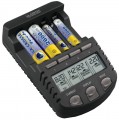Min. charge current
The smallest current that the device can provide in charge mode. If this parameter is specified in the specifications, this means that this model has the ability to adjust the charge current (otherwise, only the maximum current is indicated).
Charging current is one of the most important parameters for any charger: see “Maximum charge current. And the general range of current adjustment depends on this indicator: the lower the minimum value (with the same maximum) — the more extensive the possibilities for setting up the "charger" for the specific specifics of work.
Max. charge current
The highest current that the device can provide when charging the battery (or the nominal value of the charging current, if it is not adjustable).
Charging current is one of the most important parameters for any charger: it determines the speed of the process and compatibility with certain batteries. In general, the higher the current, the faster the process, the less time it takes to charge. At the same time, some batteries may have recommendations for the optimal current strength and restrictions on its maximum values. Therefore, mindlessly chasing a powerful charger is not worth it: at first it's ok to clarify how justified such power will be.
Note that in multi-channel devices (see "Independent channels"), the maximum current strength can be achieved when only part of the channels are operating. The indicators provided when all channels are operating simultaneously are indicated separately for such models (see "Charge current (all channels)").
Charge current (all channels)
The highest current provided by a multi-channel charger (see "Independent channels") at full load, with all slots (and, accordingly, channels) operating. In fact, a guaranteed maximum current provided by a multi-channel charger, regardless of the number of channels involved.
For the total charge current, see “Maximum charge current. Here we note that the full load is a rather complex mode in which the current strength can decrease. Therefore, this parameter is specified separately.
Number of settings
The number of separate charge current settings (see above) provided in the design of the charger. For example, a device with 4 settings may provide options for 200, 400, 800 and 1000 mAh. In general, the larger this number, the more accurately you can choose the charging current for a particular situation.
Min. discharge current
The smallest current that the device is capable of providing in battery discharge mode.
Some specific functions are based on the discharge of the battery installed in the charger (see below for more details); in this case, it often becomes necessary to set a certain value of current strength, which is optimal for a given battery. The lower the minimum discharge current (with the same maximum) — the wider the adjustment range and the higher the probability that the device will be able to provide the optimal discharge mode.
Max. discharge current
The highest current that the device can provide in battery discharge mode.
Some specific functions are based on the discharge of the battery installed in the charger (see below for more details). The higher the maximum value of the discharge current, the less time it takes to “drain” energy from the battery. On the other hand, for some types of batteries and discharge modes, specific current recommendations may be provided, and exceeding them can be fraught with overload, overheating, and even fire. Therefore, it is necessary to specifically pursue high values of the discharge current only if it is justified from a technical point of view.
Capacity measurement
A procedure that allows you to quickly determine the capacity of the installed battery. Actually, the main advantage
of capacitance measurement is speed. On the other hand, the results are not particularly accurate, and usually they only show the nominal, not the actual capacity - to determine the latter, it is better to use the function of checking the remaining capacity.
Fault detection
A diagnostic system capable of detecting faulty batteries, disconnecting them from power and notifying the user. The
fault detection function is useful not only for checking the performance as such: a battery malfunction that is not detected in time is fraught with equipment damage, and in some cases even fires.
USB output charging gadgets
The ability to use the charger to charge portable electronics - smartphones, tablets, players, etc. As a rule, for this, a
USB port is provided in the design, for connection to which an appropriate cable is required; in fact, you can charge from such a device not only mobile gadgets, but also any equipment that can be powered from USB. True, it is worth noting that some manufacturers do not recommend using third-party devices for their equipment if they are not officially approved.

